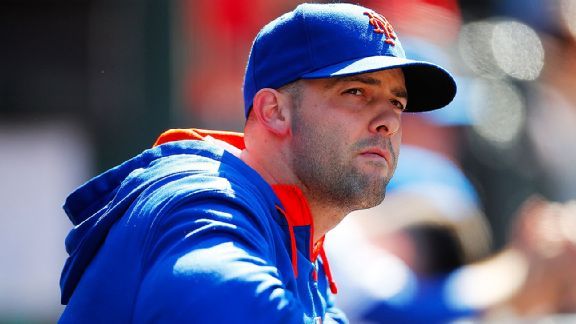 Mike Stobe/Getty Images
Mike Stobe/Getty ImagesOpening Day starter Dillon Gee is projected to earn $4.99 million in 2015.

Pace Law School in White Plains won the sixth-annual Tulane National Baseball Arbitration Competition in 2013 in New Orleans. This week, Dan Masi (Pace ’14) and Jesse Kantor (Pace ’15) offer their salary projections for the Mets’ arbitration-eligible players, including detailed analyses for Lucas Duda, Dillon Gee, Jenrry Mejia and Daniel Murphy.
The Pace Law arbitration team is using the same methods agents and team officials employ.
On Day 3, here is an analysis of Gee's projected 2015 salary.
Introduction
Dillon Gee started on Opening Day this past season and seemed poised to improve on his 2013 performance. However, his campaign was plagued by a strained right lat muscle, which caused him to miss two months during the middle of the season. The injury limited Gee to only 137.1 innings and will likely impact his 2015 salary.
Prior to the setback, Gee was cruising for the Mets, recording a 3-1 record and 2.73 ERA. Three-quarters of his outings resulted in a Quality Start (QS). After returning from injury on July 9, his ERA the remainder of the season ballooned to 4.78, he posted a 4-7 record and a QS rate of only 36 percent.
Gee will see an increase from his $3.625 million salary of this past season, but with only a partial season under his belt, the figure will be lower than he would hope.
The Case for the New York Mets
The Mets will argue that Gee’s injury hurts his value to the team. While an effective starter when healthy, the Mets are not able to rely on Gee to take the hill every fifth day. Having only approached the 200-inning plateau once in his career (199 IP in 2013), Gee simply cannot be paid as the workhorse ace of the staff.
The two-run difference in his ERA after the injury shows he was less effective after his return.
Earning a quality start in only 50 percent of his starts, Gee was worse than any of the Mets qualified starters and 6 percent lower than the league average.
The Mets will look to find other starting pitchers who suffered injuries, or limited innings, in their platform seasons to use as comparable players.
The Case for Dillon Gee
Gee will argue that his mediocre record was due more to the failings of the Mets lineup. Gee received only 3.27 runs per game of support in 2014 -- the eighth-lowest amount among NL pitchers out of 59 with at least 120 inning pitched.
While he may have suffered after returning from the injury, the fact that he returned demonstrated he is healthy and able to rebound.
Coming off a 199-inning season in 2013, Gee has the ability to be an effective pitcher and contribute for the Mets in 2015.
Gee also will likely argue that his career numbers trump any deficiency in his platform-year statistics. Gee will look for pitchers with similar career numbers to get the highest total salary possible and offset the limited raise he will receive.
Comparable Players
GEE vs. ESTRADA, NORRIS AND HAPP
A statistical comparison for the platform seasons (year heading into second arbitration) and careers to that point of Dillon Gee, Marco Estrada, Bud Norris and J.A. Happ.
Marco Estrada -- 2013 -- Salary: $3.325M -- Raise from previous year: $1.37M
Marco Estrada represents a perfect barometer for Gee’s injury-shortened season. In 2013, Estrada started only 21 games because of injury. He recorded 121 innings and a 7-4 record. Further, he finished with a lower ERA and WHIP than Gee while proving to be the more effective pitcher overall. Estrada tops Gee in strikeouts, quality starts, QS percentage, and has a better batting average against (BAA). With inferior platform-year statistics, Gee shouldn’t receive a greater raise than Estrada received only last year.
J.A. Happ -- 2012 -- Salary: $3.7M -- Raise from previous year: $1.35M
Where Estrada represents the ceiling of Gee’s potential raise, Happ should represent the floor. In 2012, Happ started 24 games and logged 144.2 innings and a 10-11 record. His 4.79 ERA and 1.40 WHIP were significantly higher than both Gee and Estrada’s statistics in those categories. However, even with inferior statistics, Happ received only $20,000 less than the $1.37 million Estrada was paid in his comparable season. Gee outperformed Happ and should receive a raise greater than $1.35 million.
Bud Norris -- 2013—Salary: $5.35M -- Raise from previous year: $2.3M
Bud Norris is a good comp to use to determine whether Gee’s total salary amount is warranted. After the 2013 season, Norris received a $5.3 million salary based on his platform year and career statistics. While it is evident Norris had the better platform year, primarily because of a lack of injury issues, a look at their respective careers will help determine what Gee should be paid. While Gee was paid more following his first arbitration season, his 2013 statistics warranted the head start. However, Gee regressed in 2014 and he should be paid less than Norris’ $5.3 million.
Predicted Result
Using the Estrada and Happ comps to base a salary-raise argument, it seems fitting Gee should receive a raise near the $1.37 million Estrada received in 2013. However, since it is difficult to argue Gee outperformed Estrada, a slightly smaller raise makes sense. With more than 100 fewer innings pitched, a salary below Norris’ $5.3 million also seems reasonable.
Based on his platform and career statistics and the comparable players cited above, we predict Gee to receive a raise of $1.365 million and a total salary of $4.99 million in 2015.
